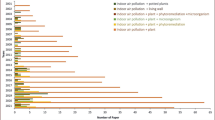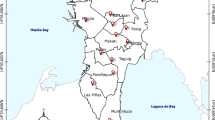Abstract
Wastewater treatment plants (WWTPs) may be a source of nuisance in neighbouring places due to hydrogen sulphide (H2S) and BTEX (benzene, toluene, ethylbenzene, and xylenes) emissions. In this study, samples were collected from WWTP workplace ambient air and outdoor ambient air around one of the largest WWTPs in Istanbul with a capacity of 250,000 m3/day to evaluate the effects of H2S and BTEX emissions. Samples were collected in three seasons for 15-day durations: winter (November 2015), spring (May 2015), and summer (August 2016). Average concentrations of H2S and BTEX were determined as 1.1 and 56.2 µg/m3, respectively. Average concentrations BTEX components were 4.9, 20.7, 6.4, and 24.2 µg/m3, respectively. Health risk assessment for plant workers and local residents was performed for H2S and BTEX inhalation exposure using the method by USEPA. Results show that H2S and BTEX emissions do not have harmful effects on human health.



Similar content being viewed by others
Data availability
Data will be made available on reasonable request.
References
ATSDR. (2004). Agency for toxic substances and disease registry. Interaction profile for: Benzene, toluene, ethylbenzene and xylenes (BTEX). US Department of Health and Human Services. Public Health Service. Atlanta. USA.
Brattoli, M., Gennaro, G., Mazzone, A., Giua, R., & Assenato, G. (2016). Automated collection of real-time alerts of citizens as a useful tool to continuously monitor malodorous emissions. International Journal of Environmental Research and Public Health, 13, 3–263.
Berlin, R., Brown, R. H., & Saunders, K. J. (Eds.). (1987). Diffusive Sampling: An alternative approach to workplace air monitoring. Royal Society of Chemistry.
Buczynska, A. J., Krata, A., Stranger, M., Godoi A. F. L., Kontozova-Deutsch, V., Bencs, L., & Van Grieken, R. (2009). Atmospheric BTEX-concentrations in an area with intensive street traffic. Atmospheric Environment 43:311–318.
Choi, S. W., Park, S. W., Lee, C. S., Kim, H. J., Bae, S., & Inyang, H. I. (2009). Patterns of VOC and BTEX concentration in ambient air around industrial sources in Daegu, Korea. Journal of Environmental Science and Health, 44, 99–107.
Cruz, L. P., Alve, L. P., Santos, A. V., Esteves, M. B., Gomes, Í. V., & Nunes, L. S. (2017). Assessment of BTEX concentrations in air ambient of gas stations using passive sampling and the health risks for workers. Journal of Environmental Protection, 8, 12–25.
Demir, S., Saral, A., Isik, D., Akyildiz, A., Kuzu, S. L., Mert, S., Demir, G., & Goncaloglu, B. I. (2011). Characterization of ambient volatile organic compounds and their diurnal variations in Istanbul, Turkey. Environmental Fresenius, 20, 2951–2958.
Dhada, I., Nagar, P. K., Sharma, M., & Gupta, N. (2016a). Photo-catalytic oxidation technology for VOC control: evaluation and risk characterization of intermediates of benzene degradation adsorbed on catalyst. Environmental Engineering Science, 33(12), 970–977.
Dhada, I., Sharma, M., & Nagar, P. K. (2016). Quantification and human health risk assessment of by-products of photo catalytic oxidation of ethylbenzene, xylene and toluene in indoor air of analytical laboratories. Journal of Hazardous Materials, 316, 1–10.
Dhada, I., Nagar, P. K., & Sharma, M. (2016c). Photo-catalytic oxidation of individual and mixture of benzene, toluene and p-xylene. International Journal of Environmental Science and Technology, 13(1), 39–46.
Dincer, F., Odabasi, M., & Muezzinoglu, A. (2006). Chemical characterization of odorous gases at a landfill site by gas chromatography–mass spectrometry. Journal of Chromatography, 1122, 222–229.
Durmusoglu, E., Taspinar, F., & Karademir, A. (2010). Health risk assessment of BTEX emissions in the landfill environment. Journal of Hazardous Materials, 176, 870–877.
EEA. (2008). European Environment Agency. 2008. Directive on ambient air quality and cleaner air for Europe. The European Union Parliament and the Council European Environment Agency. 21.5.2008–50/EC-152.
Ercan, Ö., Dinçer, F., & Ceylan, Ö. (2019). Spatial and seasonal variations of atmospheric BTEX, sulfur dioxide, nitrogen dioxide, and ozone concentrations in Istanbul, and health risk assessment of BTEX. Environmental Forensics, 20, 149–161.
Ergenekon, P., & Ulutaş, K. (2014). Heavy metal content of total suspended air particles in the heavily industrialized town of Gebze, Turkey. Bulletin of Environmental Contamination and Toxicology, 92, 90–95.
Gee, I. L., & Sollars, C. J. (1998). Ambient air levels of volatile organic compounds in Latin American and Asian cities. Chemosphere, 36, 2497–2506.
Ghio, A. J., Soukup, J. M., & Madden, M. C. (2018). The toxicology of air pollution predicts its epidemiology. Inhalation Toxicology, 30, 327–334.
Guo, H., Lee, S. C., Li, W. M., & Cao, J. J. (2003). Source characterization of BTEX in indoor microenvironments in Hong Kong. Atmospheric Environment, 37, 73–82.
IRIS. (2020). Integrated Risk Information System. https://cfpub.epa.gov/ncea/iris_drafts/atoz.cfm?list_type=alpha. Accessed 10 July 2020.
Lavu, M., Bhushan, S., & Lefer, D. J. (2011). Hydrogen sulfide-mediated cardioprotection: Mechanisms and therapeutic potential. Clinical Science, 120, 219–229.
Lewkowska, P., Cieślik, B., Dymerski, T., Konieczka, P., & Namieśnik, J. (2016). Characteristics of odors emitted from municipal wastewater treatment plant and methods for their identification and deodorization techniques. Environmental Research, 151, 573–586.
MEF. (2008). Ministry of Environment and Forestry. Regulation on air quality assessment and management. 26898:06 June 2008.
MLSS. (2013a). Ministry of Labor and Social Security. Regulation on health and safety precautions in working with cancerogenes or mutagenes. 28730:06 August 2013.
MLSS. (2013b). Ministry of Labor and Social Security. Regulation on Health and Safety Measures in Working with Chemical Substances. 28733:12 August 2013.
Ölmez, S. S. (2008). Odour control in wastewater treatment plants using ozonation and chemical scrubbing. Dissertation, Marmara University.
Padhi, B., & Padhy, P. (2008). Assessment of intra-urban variability in outdoor air quality and its health risks. Inhalation Toxicology, 20, 973–979.
Periago, J. F., Zambudio, A., & Prado, C. (1997). Evaluation of environmental levels of aromatic hydrocarbons in gasoline service stations by gas chromatography. Journal of Chromatography, 778, 263–268.
RAIS. (2020). Risk Assessment Information System. 2020. https://rais.ornl.gov/cgi-bin/tools/TOX_search?select=chemtox. Accessed 10 July 2020.
Ryan, P. H., & LeMasters, G. K. (2007). A review of land-use regression models for characterizing intraurban air pollution exposure. Inhalation Toxicology., 19, 127–133.
Sharma, R. K., Agrawal, M., & Marshall, F. (2007). Heavy metal contamination of soil and vegetables in suburban areas of Varanasi, India. Ecotoxicology and Environmental Safety, 66, 258–266.
Srivastava, S., Kumar, A., Bauddh, K., Gautam, A. S., & Kumar, S. (2020). 21-day lockdown in India dramatically reduced air pollution indices in Lucknow and New Delhi, India. Bulletin of Environmental Contamination and Toxicology, 105, 9–17.
Thomas, D. S. (2007). Reducing Hydrogen Sulfide (H2S) concentrations at wastewater collection systems and treatment facilities using chemical oxidation. Dissertation, Florida State University.
Tsang, A. M., & Klepeis, N. E. (1996). Descriptive statistics tables from a detailed analysis of the national human activity pattern survey (NHAPS) (No. PB-98–155179/XAB). EPA National Exposure Research Lab Las Vegas.
Ulutas, K. (2017). Determination of odor emission characteristics and environmental effects by dispersion modeling in Tuzla Biological Wastewater Treatment Plant. Dissertation, Kocaeli University.
USEPA. (1986). United States Environmental Protection Agency. Guidelines for carcinogen risk assessment, federal register. 51(185):33992–34003 Washington DC.
USEPA. (1989). United States Environmental Protection Agency. Risk Assessment guidance for superfund, volume I: human health evaluation manual (Part A). EPA/540/1–89/002 Washington DC.
USEPA. (2000). United States Environmental Protection Agency. Risk characterization handbook. EPA 100-B-00–002 Washington DC.
USEPA. (2020). United States Environmental Protection Agency. Human Health Risk Assessment. https://www.epa.gov/risk/human-health-risk-assessment#self. Accessed 14 July 2020.
Whiteman, M., & Winyard, P. G. (2011). Hydrogen sulfide and inflammation: The good, the bad, the ugly and the promising. Expert Review of Clinical Pharmacology, 4, 13–32.
WHO. (1987). World Health Organisation. IARC Monographs on the evaluation of carcinogenic risks to humans. overall evaluations of carcinogenicity 1–42, Supplement 7. International Agency for Research on Cancer. https://monographs.iarc.fr/wp-content/uploads/2018/06/Suppl7.pdf. Accessed 14 July 2020.
WHO (2000) World Health Organisation. Hydrogen sulfide: Air quality guidelines Copenhagen
Zhang, X., & Bian, J. S. (2014). Hydrogen sulfide: A neuromodulator and neuroprotectant in the central nervous system. ACS Chemical Neuroscience, 5, 876–883.
Zhang, Y., Mu, Y., Liu, J., & Mellouki, A. (2012). Levels, sources and health risks of carbonyls and BTEX in the ambient air of Beijing, China. Journal of Environmental Sciences, 24, 124–130.
Zou, S. C., Lee, S. C., Chan, C. Y., Ho, K. F., Wang, X. M., Chan, L. Y., & Zhang, Z. X. (2003). Characterization of ambient volatile organic compounds at a landfill site in Guangzhou, South China. Chemosphere, 51, 1015–1022.
Funding
The authors received financial support from Kocaeli University, Scientific Research Project Funding (BAP) (Project number 2015/23).
Author information
Authors and Affiliations
Corresponding author
Additional information
Publisher's Note
Springer Nature remains neutral with regard to jurisdictional claims in published maps and institutional affiliations.
Rights and permissions
About this article
Cite this article
Ulutaş, K., Kaskun, S., Demir, S. et al. Assessment of H2S and BTEX concentrations in ambient air using passive sampling method and the health risks. Environ Monit Assess 193, 399 (2021). https://doi.org/10.1007/s10661-021-09164-1
Received:
Accepted:
Published:
DOI: https://doi.org/10.1007/s10661-021-09164-1




